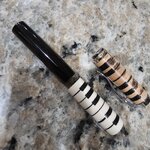DMacinID
Member
Hey Folks,
I'm working on a pen design for a gift to a piano player.
It's segmented with Maple as the keys, thin Walnut as the "spaces", and Gaboon Ebony for the flat/sharp keys.
This was my 2nd (3rd?) attempt, so I went ahead and finished/assembled it, even though it didn't turn out as planned.
I read through this thread <https://www.penturners.org/threads/not-so-much-showing-off-a-pen-as-a-lesson-learned.149337/>, where the OP asked two questions (re: busy segments, and Maple discoloration), but the discussion focused on segmenting.
I'd love to hear any tips/tricks/wisdom anyone can share about what might have happened to the Maple, and how to avoid it. I think it's just sanding dust from the Ebony. BUT, not sure what I can do to mitigate (or better yet, eliminate!) the problem.
I'm all ears!
- DMac

I'm working on a pen design for a gift to a piano player.
It's segmented with Maple as the keys, thin Walnut as the "spaces", and Gaboon Ebony for the flat/sharp keys.
This was my 2nd (3rd?) attempt, so I went ahead and finished/assembled it, even though it didn't turn out as planned.
I read through this thread <https://www.penturners.org/threads/not-so-much-showing-off-a-pen-as-a-lesson-learned.149337/>, where the OP asked two questions (re: busy segments, and Maple discoloration), but the discussion focused on segmenting.
I'd love to hear any tips/tricks/wisdom anyone can share about what might have happened to the Maple, and how to avoid it. I think it's just sanding dust from the Ebony. BUT, not sure what I can do to mitigate (or better yet, eliminate!) the problem.
I'm all ears!
- DMac

